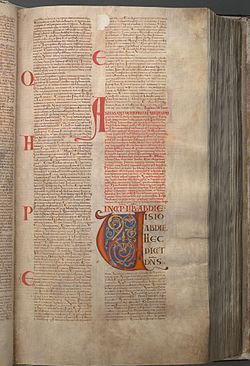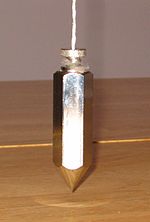Amos 7
| Amos 7 | |
|---|---|
 | |
| Book | Book of Amos |
| Category | Nevi'im |
| Christian Bible part | Old Testament |
| Order in the Christian part | 30 |
Amos 7 is the seventh chapter of the
Text
The original text was written in Hebrew. This chapter is divided into 17 verses. Some early manuscripts containing the text of this chapter in Hebrew are of the Masoretic Text tradition, which includes the Codex Cairensis (895), the Petersburg Codex of the Prophets (916), Aleppo Codex (10th century), Codex Leningradensis (1008).[8] Fragments cumulatively containing all verses of this chapter in Hebrew were found among the Dead Sea Scrolls including 4Q78 (4QXIIc; 75–50 BCE) with extant verses 1–16;[9][10][11] 4Q82 (4QXIIg; 25 BCE) with extant verses 1, 7–12, 14–17;[10][12][13] DSS F.Amos1 (DSS F.181; 1–30 CE) with extant verse 17;[10][14] and Wadi Murabba'at (MurXII; 75–100 CE) with extant verses 3–6, 8–17.[10]
There is also a translation into Koine Greek known as the Septuagint, made in the last few centuries BCE. Extant ancient manuscripts of the Septuagint version include Codex Vaticanus (B; B; 4th century), Codex Alexandrinus (A; A; 5th century) and Codex Marchalianus (Q; Q; 6th century).[15][a]
Verses 1-3: the vision of the locusts
- Thus the Lord God showed me: Behold, He formed locust swarms at the beginning of the late crop; indeed it was the late crop after the king’s mowings.[17]
Jennifer Dimes suggests that the "king's mowings" was a tax;[18][19] the Jerusalem Bible suggests that the king exacted a part of the first crop to feed his horses.[20] The "late" or "second" crop suggests a multiple cropping process was in place.[21]
Verses 4-6: the vision of a fire
- Thus the Lord God showed me: Behold, the Lord God called for conflict by fire, and it consumed the great deep and devoured the territory.[22]
The Jerusalem Bible associates the fire with a drought,[23] the "first manifestation of the judgment of the LORD", anticipated in Amos 1:2: The green pastures of the shepherds will turn brown and die. Even Mount Carmel will become dry.[24][25] On the LORD "contending" or "disputing" by fire, Samuel Driver notes the words of Isaiah, for by fire and by His sword, the Lord will judge all flesh.[26]
Verses 7-9: the plumb-line

- And the Lord said unto me,
- Amos, what seest thou?
- And I said, A plumbline.
- Then said the Lord,
- Behold, I will set a plumbline in the midst of my people Israel:
- I will not again pass by them any more:[27]
- "Amos, what seest thou?" God calls the prophet by name, as a familiar friend, just as He said to Moses, "I know you by name" Exodus 33:12, Exodus 33:17. For "the Lord knows them that are His" (2 Timothy 2:19).[28]
- "Plumbline" or "plumb bob"; "plummet": a tool to measure not only for building, but also for pulling down (see 2 Kings 21:13; Isaiah 34:11; Lamentations 2:8), which should be done "in the midst" of the people, that all might be tried individually, and that all might acknowledge the justice of the sentence, which is a complete ruin.[29] The Vulgate Latin version renders it, "a plasterer's" or "mason's trowel"; with which they lay their plaster and mortar on in building: the Septuagint translates as "an adamant", and it is called "anachites" by Pliny,[30] a word in sound near to this here used: the Targum renders it, "judgment": but Jarchi and Aben Ezra observe that in the Arabic tongue it signifies "lead" or "tin",[31] and thus "a line with lead at the end of it".[32]
- "Not … pass by … any more": "not forgive them any more" (Amos 8:2; Proverbs 19:11; Micah 7:18).[5]
Verses 10-17: Amos and Amaziah
In this "historical account of Amaziah's opposition to Amos",[33] Amos is expelled from Bethel, where he had been warning about the impending threat to the northern Kingdom. Michael Coogan suggests that these verses "interrupt" the sequence of visions.[7] Dimes treats this part as a "central narrative" which "demonstrates why judgement is irrevocable".[18] F. E. Gigot considers it "probable" that Amos left Bethel in compliance with Amaziah's directives, and "withdrew to Juda[h]".[33]
See also
Notes
- ^ The extant Codex Sinaiticus currently does not have the whole Book of Amos.[16]
References
- ^ Collins 2014.
- ^ Hayes 2015.
- ^ Metzger, Bruce M., et al. The Oxford Companion to the Bible, New York: Oxford University Press, 1993
- ^ Keck, Leander E. 1996, The New Interpreter's Bible: Volume: VII. Nashville: Abingdon
- ^ a b Robert Jamieson, Andrew Robert Fausset; David Brown. Jamieson, Fausset, and Brown's Commentary On the Whole Bible. 1871.
 This article incorporates text from this source, which is in the public domain.
This article incorporates text from this source, which is in the public domain.
- ^ Jerusalem Bible (1966), Sub-headings in Amos 7:1-9
- ^ a b Coogan, Michael (2009). A Brief Introduction to the Old Testament. p. 256.
- ^ Würthwein 1995, pp. 35–37.
- ^ Ulrich 2010, p. 607.
- ^ a b c d Dead sea scrolls – Amos
- ^ Fitzmyer 2008, p. 38.
- ^ Ulrich 2010, pp. 606–608.
- ^ Fitzmyer 2008, p. 39.
- ^ Tov, Emanuel (2014) New Fragments of Amos. Dead Sea Discoveries 21:3–13.
- ^ Würthwein 1995, pp. 73–74.
- ^
 This article incorporates text from a publication now in the public domain: Herbermann, Charles, ed. (1913). "Codex Sinaiticus". Catholic Encyclopedia. New York: Robert Appleton Company.
This article incorporates text from a publication now in the public domain: Herbermann, Charles, ed. (1913). "Codex Sinaiticus". Catholic Encyclopedia. New York: Robert Appleton Company.
- ^ Amos 7:1: New King James Version
- ^ a b Dines, J. M., 29. Amos, in Barton, J. and Muddiman, J. (2001), The Oxford Bible Commentary, p. 587
- ^ cf. Catholic Book Publishing Corp., Footnote a at Amos 7:1 in the New Catholic Bible
- ^ Jerusalem Bible (1966), Footnote a at Amos 7:1
- ^ Keil, C. F. and Delitzsch, F., Keil and Delitzsch OT Commentary on Amos 7, accessed 25 December 2023
- ^ Amos 7:4: NKJV
- ^ Jerusalem Bible (1966), Footnote e at Amos 7:4
- ^ Amos 1:2: Easy-to-Read Version
- ^ Jerusalem Bible (1966), Footnote b at Amos 1:2
- ^ Driver, S. R. (1898), Cambridge Bible for Schools and Colleges on Amos 7, accessed 26 December 2023, referencing Isaiah 66:16
- ^ Amos 7:8: KJV
- ^ Barnes, Albert. Notes on the Old Testament. London, Blackie & Son, 1884. Reprint, Grand Rapids: Baker Books, 1998.
 This article incorporates text from this source, which is in the public domain.
This article incorporates text from this source, which is in the public domain.
- ^ Joseph S. Exell; Henry Donald Maurice Spence-Jones (Editors). The Pulpit Commentary. 23 volumes. First publication: 1890.
 This article incorporates text from this source, which is in the public domain.
This article incorporates text from this source, which is in the public domain.
- ^ Pliny, Nat. Hist. l. 3. c. 4.
- ^ "plumbum, sive nigrum, sive album puriusque", Camusus; "plumbum et stannum", Ibn Maruph apud Golium, col. 176. Avicenna apud Castel. col. 161. Vid. Hottinger. Smegma Oriental. l. 1. c. 7. p. 122.[clarification needed]
- ^ Gill, J., John Gill's Exposition of the Entire Bible. Exposition of the Old and New Testament. Published in 1746–1763.
 This article incorporates text from this source, which is in the public domain.
This article incorporates text from this source, which is in the public domain.
- ^ a b
 This article incorporates text from a publication now in the public domain: Herbermann, Charles, ed. (1913). "Amos". Catholic Encyclopedia. New York: Robert Appleton Company.
This article incorporates text from a publication now in the public domain: Herbermann, Charles, ed. (1913). "Amos". Catholic Encyclopedia. New York: Robert Appleton Company.
Sources
- Collins, John J. (2014). Introduction to the Hebrew Scriptures. Fortress Press. ISBN 9781451469233.
- ISBN 9780802862419.
- Hayes, Christine (2015). Introduction to the Bible. Yale University Press. ISBN 978-0300188271.
- Ulrich, Eugene, ed. (2010). The Biblical Qumran Scrolls: Transcriptions and Textual Variants. Brill.
- ISBN 0-8028-0788-7. Retrieved January 26, 2019.

